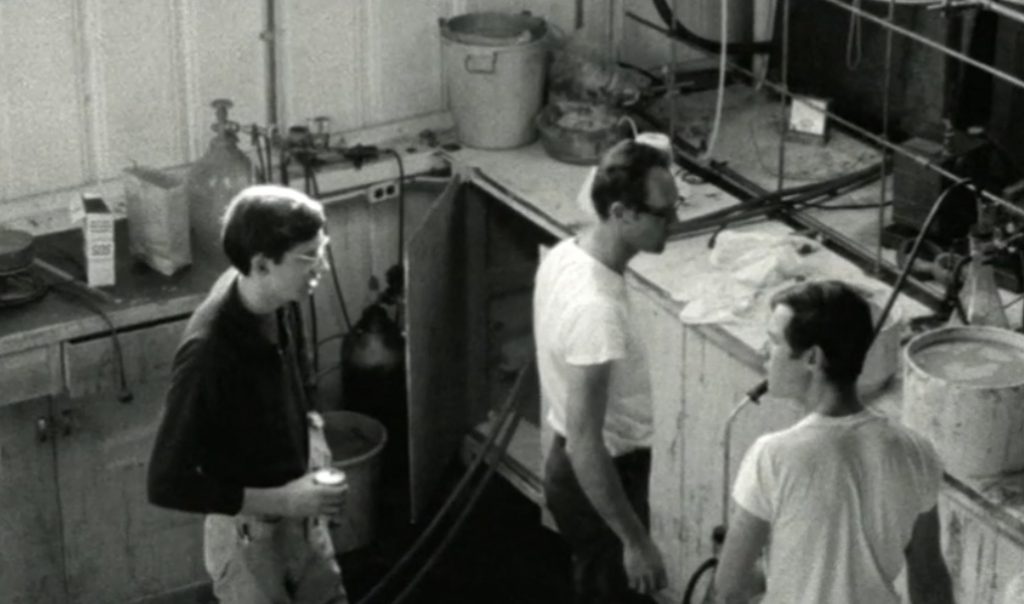Executive Summary: Different labs use different standards for reporting percentage purity assessments and also for mass when doing quantitative measurements for psychoactive drugs like MDMA. One lab’s 84% might be another lab’s 100%. This also means one lab’s 84 mg might be another lab’s 100 mg.
Long Version:
Erowid friend and Internet drug geek, Borax, pointed out a paper that analyzed some of the Dutch Trimbos Institute’s DIMS data. The peer-reviewed article was published in the journal Addiction: “Purity, adulteration and price of drugs bought online versus offline in the Netherlands” (2016). We love the Dutch DIMS testing service and have written about it before.
The publication of this article did not reveal a lot that we didn’t already know, but has brought into focus a heated argument that has been ongoing in public and private discussion forums about analytical methodologies for on-site and lab drug analysis.
What does it mean when a lab reports that a powder is 100% pure MDMA? What does it mean when a lab reports that a tablet contains 100 mg of MDMA?
The reason for writing about this is that there are no simple answers to those questions, though it seems like there should be.
Some online vendors of research chemicals have stated that various labs’ purity results in the 75-85% range mean that the sample was really “100% pure”, because of different ways of handling the mass of the sort-of-attached non-psychoactive salt anion. An anion is a negatively charged counter-ion that balances the positively charged, nitrogen-bearing drug molecule. When freebases are turned into salts, an anion is added.
The main case and the one that’s relatively easy to talk about is MDMA. MDMA is normally produced and distributed as MDMA hydrochloride (HCl), which is MDMA in a solution that has been converted to a crystalline form—-a “salt”-—by bubbling hydrochloric acid gas through the liquid. This causes the MDMA to turn insoluble in the solvent, precipitating out as MDMA HCl crystals. There are other possible salt forms of MDMA, but this is the “table salt” (most common salt form) of ecstasy/molly.
In fact, normal table salt or culinary salt is usually considered Sodium Chloride, or NaCl. We’re virtually swimming in tiny amounts of acids and salts in our normal environments. Remember your protective eyewear!
In addition to chloride salts like HCl, there are numerous anion salts possible, such as sulfide, fluoride, and bromide. For some psychoactive chemicals, the specific salt form can make a big difference in determining a dose. Mescaline has been distributed historically as Mescaline hydrochloride, Mescaline sulfate, Mescaline citrate, and Mescaline acetate. All of these have slightly different mass ratios between the base mescaline molecule and the portion that is the partially-bound anion. One could theoretically get 25% more or less mescaline, from a consistently weighed amount, depending on which salt form is involved.
This can be super complicated and technical and I doubt anyone is reading this who doesn’t get the basic premise. But there are technical issues like having some salt anions that bind two-to-one or one-to-two in crystalline forms. See What is the molecular weight of LSD tartrate? and many, many other discussions for crazy-making levels of detail.
As lab testing using GC/MS, HPLC, and FTIR has become more available and more projects are publishing their data and providing harm reduction information to individuals on the basis of their findings, it becomes increasingly important for more people to understand basic elements of some of the technical issues involved.
When this question of MDMA mass came up again this week, we asked the authors of the paper and the folks who work at Trimbos the following:
It has been suggested that DIMS might be using MDMA Freebase as the basis for mass and purity calculations, rather than salt masses, such as MDMA HCl. It is not described in any of your papers that I can find, but perhaps these questions will simplify the issue:
1) If DIMS received a powder sample of material that contained only MDMA HCl and nothing else, what would the reported purity be? 100%?
2) If DIMS received a tablet sample that contained 100 mg of MDMA HCl and 200 mg of lactose and inactive binders, what would the reported amount of MDMA be in that tablet? 100 mg? or would that qualify under your reporting rules as 84 mg of MDMA (freebase)?
And we got a very clear answer from the excellent Dr. Tibor Brunt:
“Indeed we use freebase as analysis standard. That actually means that if we report 100 mg MDMA in a pill, it is 119 mg in MDMA HCl. Our lab has always left out the salt component of psychoactive substances, since this component is not psychoactive. And if we’d receive a powder with 100% MDMA HCl this would be 84% maximum purity like you said.”
The reason they would define pure MDMA HCl crystal as only 84% pure is a little technical, but suffice to say it is not the only way to report an analytical result.
The reason that an expert group like Trimbos would decide to report masses this way is to normalize all their information across all salt forms of MDMA. I imagine, though I don’t know, it could be related to different types of quantitative methodologies that they have been working with for a long time.
So, dear drug geek reader, the question is not whether this issue is real, but, exactly what methodology and reporting measures are used by the analytical group you’re working with.
Update Jan 17, 2017: #
Energy Control of Spain, on the other hand, answered that they use MDMA HCl as their mass standard. They answered the questions clearly:
1) Our results directly provide the result of the salt of the substance, as
we’re using a salt as a reference standard. This means that the purity of a
sample with only MDMA HCl could be 100%.
2) Therefore, a tablet with 100mg of MDMA. HCl would be reported as 100mg
of MDMA.
Update Jan 18, 2017: Safer Party #
SaferParty and the cluster of groups in Switzerland that do work around that brand are very clear in all of their caution and warning publications that they are using MDMA HCl as their basis. For instance, “120 mg MDMA * HCl können zu viel sein”.
On Jan 30, 2017, they followed up with a long detailed answer to our questions.
Dear Earth,
Here the answer from our lab, i hope this clears things up:
As a reference standards-producing laboratory we’ve got most of our standards as solids in our hands, e.g. (water-free) salts. This is in contrast from what you get most times when buying solutions of reference standards from other companies (e.g. Cerilliant etc.). They usually sell the free base as a solution. Due to that, we are using mostly salts for calibrations. The second reason for that is, most of the time we are obtaining samples in salt forms for analysis (e.g. cocaine, heroine, MDMA, amphetamine, methamphetamine and other phenethylamines etc.); though we do not determine what kind of salt the sample consists of (e.g. hydrochloride, sulfate, acetate etc.).
We have had quite good experiences with this so far, as the sum of e.g. mixtures of amphetamine-coffeine-containing samples, when otherwise pure, reach 100% in sum when calculated with amphetamine hydrochloride. When exceeded 100% one may assume it contains a certain amount or all as free base. When the results are displayed as free base one can calculate any possible salt form. We think, according to the black market products here in Switzerland, it makes sense to give the results calculated for the hydrochloride salts, but for comparison with other labs/other countries the use of free base content would be the only value to make sense. Nevertheless, our results can easily be recalculated to the free base content, at least when knowing the type of compound we applied for calibrations/calculations.
We see it from the way that most dosage recommendations for a psychoactive compound to be taken orally or by snorting are given in the salt form (if possible), so this substantiates the indication as salt. With DMT as an example, we indicate the free base as content.
A short question the relatives the senses of indicating “purity” or “content”:
When having a chemically pure amphetamine sulfate (e.g. 100% Amphetamine sulfate”), its content of amphetamine free base is 73.4%. When having chemically pure amphetamine hydrochloride (e.g. 100% amphetamine hydrochloride), its content of amphetamine free base is 78.8%. When only seeing these numbers, which would you judge to be more pure? The lay would say it to be the second, but chemically both salt forms are chemically absolutely pure (100%).
A problem that comes in is, when having, e.g., a chemically impure amphetamine hydrochloride and reaching a displayed content of 73% amphetamine free base, one may imagine this to be a nearly chemically pure sulfate (close to the maximum content of 73.4%), but in fact it is a rather impure hydrochloride (73% out of a maximum content of 78.8%). As long as one does not determine the counterion (salt) this remains problematic.
When calibrating and calculating with salts, a measured sample consisting of free base would yield a result above 100%.
Each calibration/calculation has its own advantages, be it the use of free base, hydrochlorides, or hydrochlorides monohydrate, etc.
Let’s go to your questions:
“1) If SaferParty received a powder sample of material that contained only MDMA HCl and nothing else, what would the reported purity be? 100% ?”
As we used waterfree MDMA*HCl for calibration, we would report 100% content. As most of the samples measured here are on hand as the monohydrate (MDMA*HCl*H2O), the measured content mostly lies around a maximum of 93%.
“2) If SaferParty received a tablet sample that contained 100mg of MDMA HCl and 200mg of lactose and inactive binders, what would the reported amount of MDMA be in that tablet? 100mg ? or would that qualify under your reporting rules as 84mg of MDMA (freebase)?”
Our reported content would be 100mg MDMA*HCl.
Best regards,
For saferparty.ch
CK
Update Jan 19, 2017: The Loop #
The Loop offers analysis at music events in the UK to improve safety for partygoers and facilitate care by medical staff. When they report quantitative results for MDMA, they answered our questions as follows:
1. 100% purity
2. 100mg of MDMA (since the HCl salt is ubiquitous and service users
simply call MDMA.HCl “MDMA” we do not complicate the information they are
already getting with a description of why we are calling it something
different).
http://wearetheloop.co.uk/
Update Jan 19, 2017: CheckIt! Austria #
CheckIt! Austria very generously took their question to their technical staff and verified their answer before getting back to us:
Our chief chemist just got back to regarding your question.
We use MDMA.HCl to prepare our standards for quantitative measurements. So if we would receive sample solely consisting of MDMA.HCl, the result would be 100%. Quantitative MDMA results in tablets are also reported as HCl. So if a tablet contains 100mg MDMA.HCl and let’s say 100 mg alpha-Lactose monohydrate we would report 100mg MDMA content.


